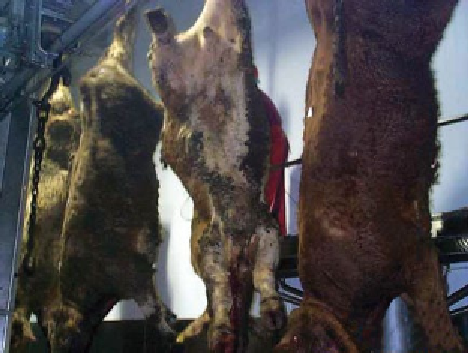Agriculture Reference
In-Depth Information
found to reduce
E. coli
O157 prevalence on hides from
56 to 34% and on carcases from 23 to 3%. Although con-
cerns remain relating to the chemical contamination of
the carcase with the detergent, commercial application is
possible.
Once the operator has applied his pre-slaughter con-
trols, the animals go forward for ante-mortem inspec-
tion. The official veterinarian can authorise slaughter
provided he is satisfied that the condition of the animals
is such that controls further down the dressing line, for
example, appropriate line speed, use of spacing etc. are
likely to be effective. At any stage, where the official
veterinarian feels that carcase hygiene may be compro-
mised, he can impose addition controls over and above
those proposed by the operator. Where additional
controls have to be imposed, the operator should review
and adjust his own controls for future processing. When
the animals are judged ready for slaughter, the quality
control team must monitor the operation closely and
control the
speed of the line
accordingly. As important as
line speed, which gives the operatives sufficient time to
carry out the extra washing of hands, arms, aprons and
sterilising equipment which will be necessary, is the
spacing of the animals. On a moving line, the placing of
carcases on every other overhead hanger decreases the
possibility of carcases touching each other and also gives
the slaughtermen more room to work hygienically. Each
slaughterman must be trained to remove contamination
by trimming as soon as it occurs. The supervisor or qual-
ity control operative must verify that this process is
effective and where contamination is occurring investi-
gate and address the problems that are causing it. A use-
ful technique that can be used as part of the verification
process is to mark the location of contamination with an
X on a carcase template the very time it is detected. Over
the course of a day, this builds up a picture of where on
the carcase most contamination is occurring and allows
trace back in the dressing process to where corrective
action needs to be taken, for example, operative retrain-
ing, more space, clips or waxed paper sheets to protect.
The inspection team must verify that the operator's con-
trols, both monitoring and verification, are effective and
insist on modification to the process or stop operations if
contamination is occurring and not being effectively
addressed.
It goes without saying, however, that the real answer
to dirty animals lies primarily with livestock producers
on the farm and to a lesser extent with hauliers.
Slaughterhouse operators have to deal with what is deliv-
ered to them. However, it may be necessary to provide an
attractive bonus payment for suppliers of clean animals
or a significant penalty for the others to bring about real
change in the supply chain.
Clipping cattle on line
Clipping after slaughter on the dressing line, as an alterna-
tive to clipping cattle in the lairage, has the advantage of
removing all animal welfare and handler health and safety
concerns. McCleery
et al.
(2008) demonstrated that both
interventions effectively reduced carcase surface contami-
nation under commercial slaughter conditions in Northern
Ireland. On-line clipping, when compared with clipping in
the lairage, resulted in a small but significance difference in
ultimate carcase pH, mean 5.59 rather than 5.66. However,
the on-line clipping facility must be so designed as to
eliminate all risk to the exposed carcase from dust created
during the clipping process. This can be achieved by physi-
cal separation of the clipping from the exposed carcase by,
for example, a two-level slaughterhouse, clipping after the
bleeding channel but before the carcase is elevated to the
floor above for dressing, making use of air curtains or by
other physical barriers. The amount of dust in the immedi-
ate area can be reduced by using vacuum incorporated into
the clipper mechanism (Fig. 8.1).
Protecting the meat from the worker
Clothing
Under European law, each food business operator must
determine what clothing is suitable to protect the food
they produce from contamination from the work force.
The key stipulation is that whatever clothing is worn, it
must be clean. Slaughterhouse operators would be wise
to look to some of the more prescriptive requirements of
the previous meat hygiene legislation as a guide to what
might be suitable. This stipulated that
'Staff handling exposed or wrapped fresh meat or working
in rooms and areas in which such meat is handled,
packaged or transported must in particular wear clean and
Figure 8.1
Clipped dirty cattle on the slaughter line (Reproduced
with permission from John Hood).

